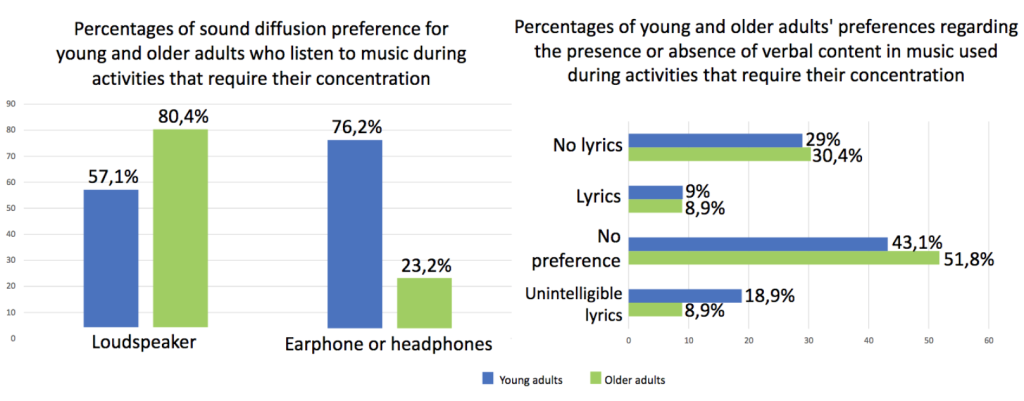Roxane Bartoletti
LAPCOS, Nice
Martine Adrian - Scotto
ICN, Nice
et Serge Antonczak, Dirk D, Steiner, Xavier Corveleyn
Paru dans HAL
INTRO
Our surroundings are composed by a multitude of sensory information (olfactive,
auditive, visual,etc) and the interactions we have with are constantly renewed.
The central nervous system integrates and assembles this multisensory data into
a rich and unified representation of our surroundings. This process, called
multisensory integration, impacts the human mental states and behaviors
(Cerisier, Haas & Kalampalikis, 2017; Furnham & Strbac, 2002; Saive et al., 2014).
The influences of olfacto-auditory multisensory integration on our cognitive
performance are based on several phenomena, such as a congruence between
stimuli based on individual preferences. Influences of music and odorants on our
cognition are still rarely studied in a standardized and individualized way,
especially on executive functions. Multisensory studies require multiple
methodologies (psychophysics, experimental psychology), techniques
(electrophysiology, odorant, and music diffusion), and skills (chemistry, cognitive
psychology, neuropsychology). Namely, no studies have investigated the
consequences of individuals’ choices of olfacto-auditory environments on young
or older adults’ executive functioning.We chose to focus on the three main
executive functions (EF) as describe in Miyake’s model: inhibition, updating, and
mental flexibility (Miyake et al., 2000; Miyake & Friedmann, 2012). EF are defined
as metacognitive processes that control and regulate other cognitive functions
(Krolak-Salmon & Thomas-Antérion, 2010) and are severely impaired during the
healthy and pathological aging of individuals (Perry & Hodges, 1999).
OBJECTIVE/AIMS
We propose exploring how customized olfacto-auditory environments impact
executive functioning performance in young and older adults. We compare the
effects of three independent variables on cognitive performance: (1) uni- or
multi-sensory, (2) customized or gold standard choice environments, for both in
(3) young and older adults. Participants' scores on experimental tasks, various
questionnaire responses, and physiological measurements are compared between
the 3 independent variables.
EXPECTED RESULTS
We expect that the congruency between smells and music experienced by each
participant will be the most powerful predictor of high cognitive performance.
Indeed, congruency of music and smells, based on participants’ choices, should
increase the influence of the multisensory environment on executive function
performance. The theoretical implications and applications in the long term can
therefore be extended to many situations: open space, school, disability, healthy
and pathological aging.
Non-Cognitive Predictors of Student Success:
We propose exploring how customized olfacto-auditory environments impact
executive functioning performance in young and older adults. We compare the
effects of three independent variables on cognitive performance: (1) uni- or
multi-sensory, (2) customized or gold standard choice environments, for both in
(3) young and older adults. Participants' scores on experimental tasks, various
questionnaire responses, and physiological measurements are compared between
the 3 independent variables.
METHODS
1. Investigate music preferences
To gain a better understanding of the musical habits of young and
older adults during cognitive efforts such as concentration during
task performance, we conducted an online survey in France to
understand the musical habits of young and older adults during
tasks that require their concentration. 381 young adults (18 to 35
years old) and 73 older adults (48 to 65 years old) have responded
to our survey. Results showed that young and older people have
musical preferences, they both tend to prefer to work while
listening to relaxing music without lyrics, classical, jazz, and
ambient music are largely preferred. Compared to older adults who
largely prefer to listen to music with a radio or music center with
loudspeakers, young people have a slight preference for the use of
ear- or headphones.

2. Gold standard obtention by material selection
The second step is the selection of the most contrasting stimuli
(music and odorants) for the two populations of interest. For this
purpose, 120 participants composed of 60 young adults (18 to 35
years old) and 60 older adults (18 to 65 years old) will listen to 24
musical excerpts and will smell 29 odorants. They will rate each
stimulus on how pleasant or unpleasant and how relaxing or
energizing they perceive it and whether they think it would help to
create a favorable environment to maintain their focus. Participants
will also rate the different emotions felt linked to the music and the
odorants.
3. Uni- and Multi-sensory environments
Finally, we will explore the effects of uni-sensory or uni- and multi-
sensory customized or imposed environments on cognitive
performance in the two populations of interest (young and older
adults). This study will focus on the three main executive functions
of Miyake’s model: inhibition, updating, and mental flexibility. In
this study, we will compare participants' scores on experimental
tasks, on various questionnaire responses, and physiological
measurements like heart rate variability and heart rate variability.
Results will be analyzed by statistical mixed models. The
congruency felt by each participant is expected to be the most
powerful predictor of high cognitive performance
